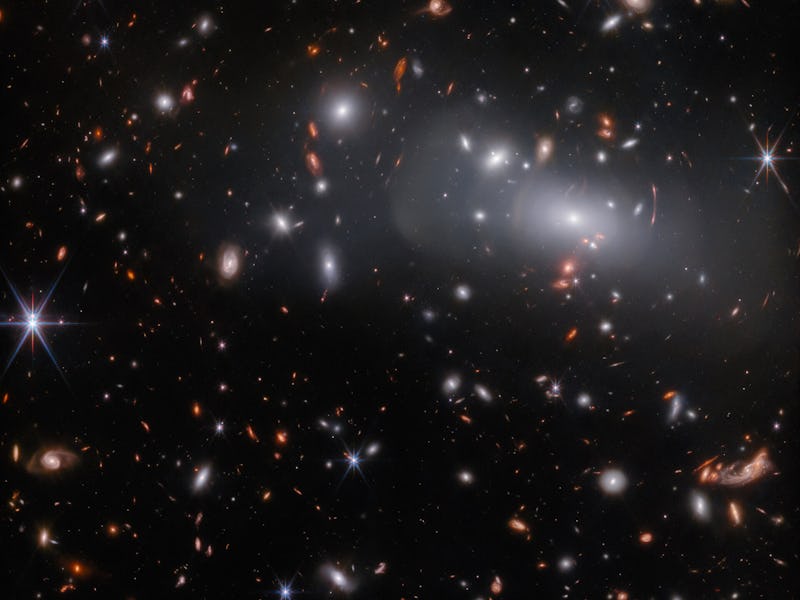Webb Telescope Captures Epic Cosmic Mirage of a Distant Galaxy
An exploding white dwarf and a massive galaxy cluster are the keys.

Some of JWST’s coolest discoveries so far have happened thanks to gravitational lensing, and now a massive galaxy cluster is about to shed some light on the phenomenon itself.
Galaxy cluster RX J2129 is about 3.2 billion light years away, and it’s so enormous that its mass actually distorts the shape of spacetime, creating a curve that bends light around the cluster. The result is like looking at something through curved glass — but on an unfathomable cosmic scale. Objects on the far side of the gravitational lens appear bigger and brighter, which means astronomers can see objects and details that might otherwise be lost to the distance. However, the lens also distorts those objects, stretching them and bending them into weird versions of their original shapes.
Triple Threat Galaxy
Gravitational lenses also tend to create multiple images of the same object. This happens because light from a distant object — let’s say a galaxy — can take more than one path around the mass of the cluster, so the light shows up multiple times on the other side even though it started from just one point. And that’s why we can see three slightly warped views of the same distant galaxy in this James Webb Space Telescope image.
All three images of the distant galaxy are labelled in this photo of galaxy cluster RX J2129, taken with JWST’s NIRCam instrument.
The galaxy you see repeated three times in this image is home to a cataclysmic stellar explosion called a supernova — or at least, it was when the light left the galaxy billions of years ago. When a massive star goes kaboom, its death throes flare bright enough to rival the light from all the 10s of billions of stars in the rest of the galaxy. It’s so bright that we can see it from our Earthly vantage point billions of light years away (with a little help from a powerful telescope like JWST and the physics of gravitational lensing).
Because the light from this distant, supernova-shellshocked galaxy follows three different paths around the curve in spacetime around the mass of RX J2129, and each path is a different length, we get to see three different snapshots of how the supernova’s brilliant glow evolved and began to fade over roughly its first three years.
The triple image of this galaxy lets astronomers measure how the supernova’s brightness faded and how its shape changed over time. Supernovae are one of the few astronomical events that happen quickly enough for humans to see in real-time.
Standard Candle
The supernova we’re watching courtesy of RX J2129’s gravitational lens was a particular type of supernova called a Type Ia. This kind of supernova happens when the burned-out core of a dead star, called a white dwarf, blows up — again.
When a white dwarf shares its orbit with another star, the white dwarf’s powerful gravity usually pulls material away from the other star. Sometimes, the two stars spiral so close to one another that they actually fall together and merge into a single star. Either way, the white dwarf is doomed; as soon as a white dwarf weighs more than about 1.4 times the mass of our Sun, it explodes dramatically enough to be seen from other galaxies.
Because white dwarfs always explode when they reach about 1.4 times the mass of our Sun — which is called the Chandrasekhar limit, below which a white dwarf is stable and above which it comes catastrophically “unbound” into stellar smithereens — the resulting explosion always produces about the same amount of light, or luminosity. And because light appears dimmer from farther away, astronomers can use these very predictable explosions to calculate how far away a galaxy actually is.
Astronomers call this a standard candle, and others include a certain type of pulsating star called a Cepheid variable.
Gravitational Lenscrafters
Using JWST’s NIRCam, astronomers will get a more precise measurement of how bright the supernova’s light appears by the time it reaches JWST’s mirrors — for all three images. Carefully analyzing that data will let astronomers measure two things: how far the light traveled on its way through the gravitational lens, and how much the lens magnifies the light’s brightness. And those two pieces of information will help astronomers measure the curves in spacetime that make up the gravitational lens itself.
That will be a bit like measuring the curves in a glass lens from a pair of eyeglasses.
“If the gravitational lens magnifies something with a known brightness, such as a Type Ia sueprnova, then astronomers can use this to measure the ‘prescription’ of the gravitational lens,” explains the European Space Agency in a recent announcement.
This article was originally published on